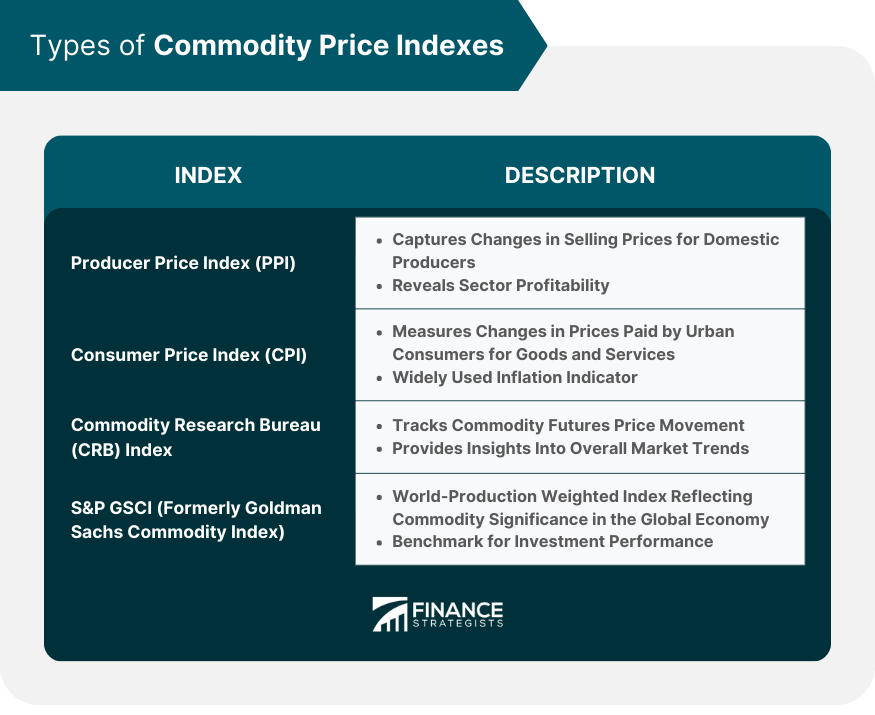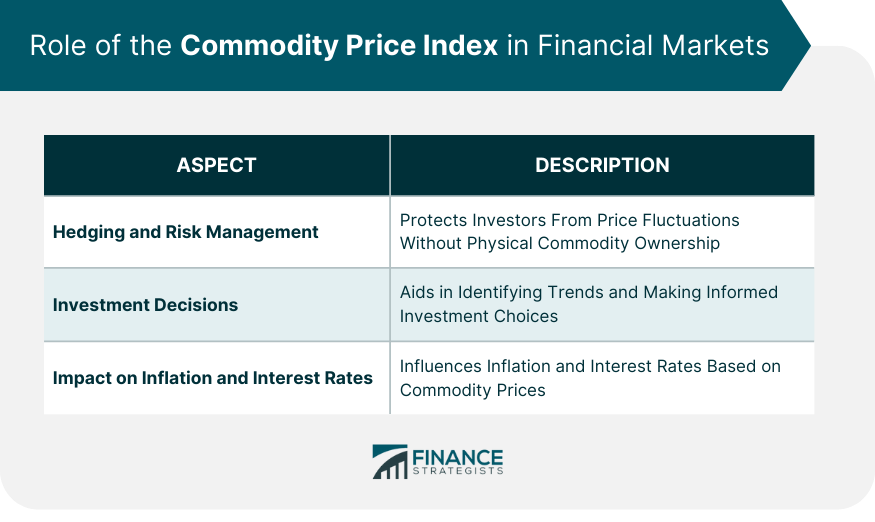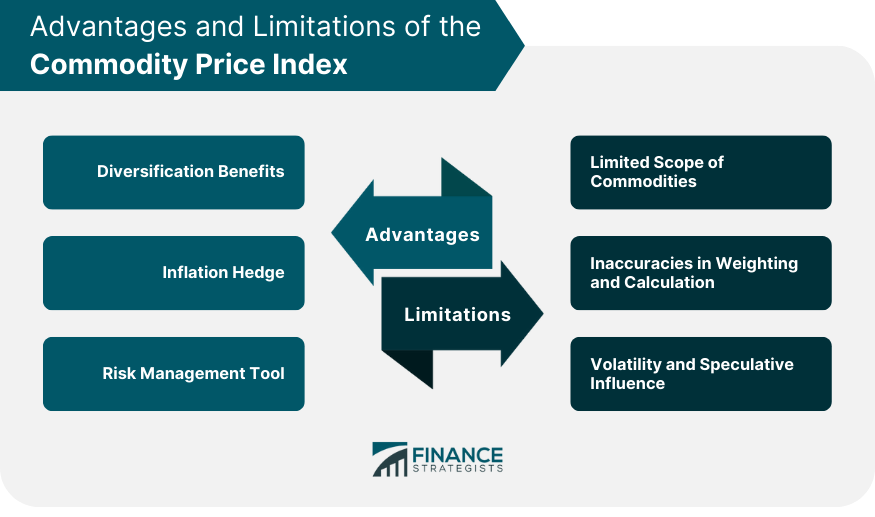The Commodity Price Index (CPI) is a statistical tool used to measure the overall direction of price movements for a group of goods. These goods, referred to as commodities, are raw materials used in the production of other goods. Examples include oil, gold, natural gas, and agricultural products like wheat and corn. The CPI provides a clear indication of commodity prices over a specified period, offering insight into the economic health of a country or region. This index is essentially a benchmark for measuring inflation or deflation in the prices of commodities. With the information it provides, businesses, consumers, and investors can gauge economic trends and make informed decisions. The CPI is often used in contracts to adjust for changes in prices during the life of a contract. The Producer Price Index (PPI) is an economic measure that captures the average changes in selling prices received by domestic producers for their output. In essence, it offers a snapshot of how much businesses are selling their goods and services for, giving a sense of the profitability of different sectors. The PPI covers almost every good-producing and service sector in the U.S. economy, including industries like agriculture, mining, manufacturing, and construction. It's important to note that the PPI differs from the CPI because it does not include services and imported goods. The Consumer Price Index (CPI) is an economic indicator that measures the average change over time in the prices paid by urban consumers for a market basket of consumer goods and services. The CPI is the most widely used measure of inflation and is often used as a tool to adjust income payments for changes in the cost of living. The CPI's market basket includes categories such as food, housing, apparel, transportation, medical care, and other goods and services. Changes in the CPI can affect the purchasing power of a consumer's income, thus influencing consumer behavior and overall economic trends. The Commodity Research Bureau (CRB) Index is a widely followed measure of commodity futures price movement. Composed of 21 commodities, it's weighted with roughly one-third allocated to energy contracts, one-third to agriculture, and one-third to metals. The CRB Index is designed to isolate and reveal the directional movement of prices in overall commodity trades. The changing values of the index represent the average of the changes in the price of the commodities that constitute the index. This offers investors an insight into the broad commodity market trends. The S&P GSCI, formerly known as the Goldman Sachs Commodity Index, is a world-production weighted index that reflects the significance of each commodity in the global economy. This index is an excellent benchmark for investment performance in the commodity markets, including energy, industrial metals, agricultural products, and livestock. The S&P GSCI offers a unique world production weighting methodology, which makes it an invaluable tool in risk management. It can capture the potential economic impact of global commodity production, thereby assisting investors and market participants in making informed investment decisions. Commodity price indexes are used as instruments for hedging and risk management in financial markets. They allow investors to protect themselves against price fluctuations in commodities. By investing in a commodity price index, an investor can hedge against commodity price risks without buying the physical commodities. For example, an airline company might invest in an oil price index to protect against potential increases in fuel costs. If oil prices rise, the index's value will increase, compensating for the increased fuel costs. Commodity price indexes also play a key role in investment decisions. They provide investors with a comprehensive view of commodity markets, helping them identify trends and make informed investment decisions. For instance, if an index shows that agricultural commodity prices are trending upwards, an investor might choose to invest in companies involved in agriculture, expecting that these companies will benefit from the rising commodity prices. Commodity price indexes can influence inflation and interest rates. High commodity prices can lead to increased inflation, as the cost of goods and services rises. Central banks often respond to high inflation by raising interest rates to control price levels. On the other hand, low commodity prices can lead to lower inflation or even deflation. In this case, central banks might reduce interest rates to stimulate economic activity. Commodities often have a low correlation with other asset classes like stocks and bonds. Therefore, adding commodities to a portfolio can reduce overall risk and potentially increase returns. Furthermore, because commodity price indexes are composed of a variety of commodities, they provide exposure to different sectors of the commodity market. This can further enhance diversification and reduce risk. Commodity prices often rise with inflation, meaning that investing in a commodity price index can protect the purchasing power of an investor's money during inflationary periods. For instance, when inflation leads to higher food and energy prices, these increases will be reflected in the commodity price index. An investment in the index can therefore offset the impact of inflation. By investing in an index, investors can protect themselves against the risks associated with individual commodities. The performance of a commodity index is based on the collective performance of its constituent commodities, reducing the risk of any single commodity's adverse price movement. For example, an investor in a broad commodity index is protected from the risk of a significant price drop in a single commodity, as the index includes many different commodities. Some indexes focus solely on energy commodities or agricultural commodities. Therefore, they may not provide a comprehensive picture of the overall commodity market. Moreover, some commodities are difficult to include in an index due to their unique characteristics. For example, certain commodities like electricity cannot be stored and are challenging to include in an index. The weighting of commodities in an index is typically based on their economic significance, but these weights can change over time due to shifts in production and consumption patterns. Moreover, the calculation of commodity price indexes can be complex and subject to estimation errors. These inaccuracies can impact the accuracy of the index and the decisions made based on it. Commodity price indexes can be volatile due to the speculative influence in commodity markets. Commodity prices can experience significant fluctuations due to speculative trading, which can lead to unstable index values. This volatility can make commodity price indexes risky investments. Moreover, it can also make them less effective as measures of inflation and other economic indicators. The Consumer Price Index is an economic indicator used to measure the average change over time in the prices paid by urban consumers for a market basket of consumer goods and services. It serves as a statistical tool for measuring price movements in a group of commodities, providing valuable insights into the economic health of countries and regions. It offers numerous advantages, including diversification benefits, inflation hedging, and risk management. By investing in a commodity index, businesses and investors can protect themselves against price fluctuations and make informed decisions. However, the CPI also has its limitations. Some indexes have a limited scope, focusing on specific commodities, which may not fully represent the overall commodity market. Additionally, inaccuracies in weighting and calculation can impact the accuracy of the index. The speculative influence in commodity markets contributes to volatility, making the indexes potentially risky and less effective as economic indicators.What Is a Commodity Price Index?
Types of Commodity Price Indexes
Producer Price Index (PPI)
Consumer Price Index (CPI)
Commodity Research Bureau (CRB) Index
S&P GSCI (Formerly Goldman Sachs Commodity Index)

Role of Commodity Price Index in Financial Markets
Hedging and Risk Management
Investment Decisions
Inflation and Interest Rates

Advantages of Commodity Price Index
Diversification Benefits
Inflation Hedge
Risk Management Tool
Limitations of Commodity Price Index
Limited Scope of Commodities
Inaccuracies in Weighting and Calculation
Volatility and Speculative Influence

Conclusion
Commodity Price Index FAQs
A Commodity Price Index is a statistical tool that measures the overall direction of price movements for a group of commodities over a specified period.
The PPI captures the average changes in selling prices received by domestic producers for their output, while the CPI measures the average change over time in the prices paid by urban consumers for a market basket of consumer goods and services.
If demand exceeds supply, commodity prices rise, while if supply surpasses demand, commodity prices drop. Various factors such as weather, natural disasters, technology, and consumer preferences influence these dynamics.
By investing in a Commodity Price Index, an investor can hedge against commodity price risks without buying the physical commodities. This strategy can protect against potential increases in commodity prices.
Limitations include a limited scope of commodities, potential inaccuracies in weighting and calculation, and volatility due to speculative influence in commodity markets.
True Tamplin is a published author, public speaker, CEO of UpDigital, and founder of Finance Strategists.
True is a Certified Educator in Personal Finance (CEPF®), author of The Handy Financial Ratios Guide, a member of the Society for Advancing Business Editing and Writing, contributes to his financial education site, Finance Strategists, and has spoken to various financial communities such as the CFA Institute, as well as university students like his Alma mater, Biola University, where he received a bachelor of science in business and data analytics.
To learn more about True, visit his personal website or view his author profiles on Amazon, Nasdaq and Forbes.















